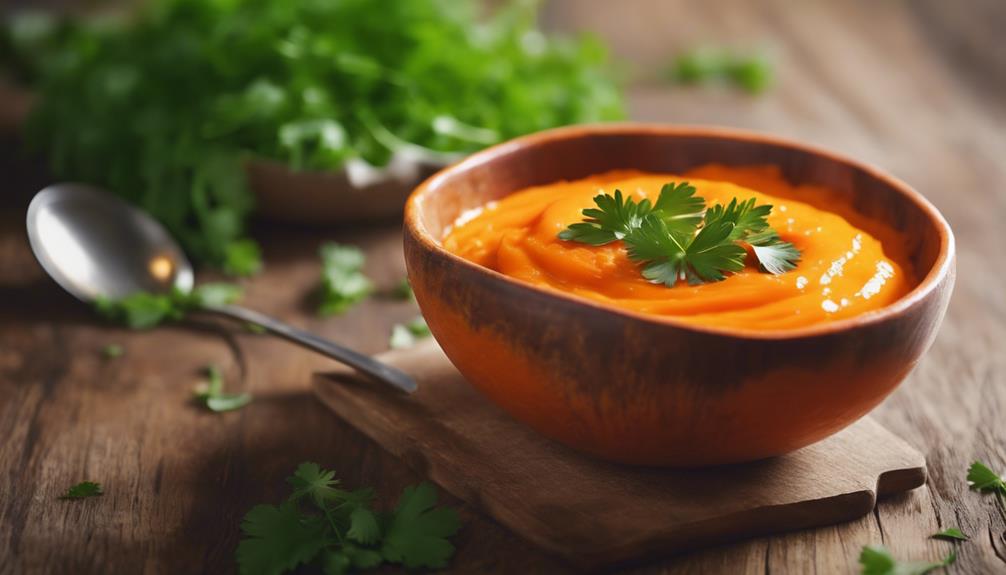Carrot puree is great for little ones starting at 6 months. Peel, chop, and cook organic carrots until soft. Then, blend until smooth. Add milk or water if needed. Use BPA-free containers to store. Keep in the fridge for up to 3 days or freeze for longer. Carrots are loaded with **vitamins A, C, iron, calcium, and fiber**. Making your own puree means you control the ingredients. It’s simple, healthy, and ensures freshness and loads of nutrients for your little one.
Key Takeaways
- Start with organic carrots for freshness and nutrients.
- Peel, chop, and cook carrots until tender.
- Blend into smooth puree for baby's easy consumption.
- Adjust consistency with milk or water.
- Store in BPA-free containers for freshness and convenience.
Benefits of Homemade Carrot Baby Food
Making your own carrot baby food at home provides numerous benefits over store-bought options, ensuring freshness and control over ingredients for your little one's nutrition.
When preparing homemade carrot puree, you have the advantage of using fresh, nutrient-rich carrots and other wholesome ingredients tailored to your baby's needs.
By choosing to make your own baby food, you can guarantee that no artificial preservatives or additives are included, offering a healthy and natural option for your little one.
Additionally, homemade carrot puree is likely to taste better than store-bought varieties, as it retains more of the original nutrients and flavors due to being freshly made.
Introducing nutrient-rich foods like carrots early on can positively impact your baby's health and development, making homemade carrot puree an excellent choice.
With homemade baby food, you have the freedom to select high-quality ingredients, ensuring that your baby receives the best possible nutrition for their growth and well-being.
Carrot Nutrition and Selection
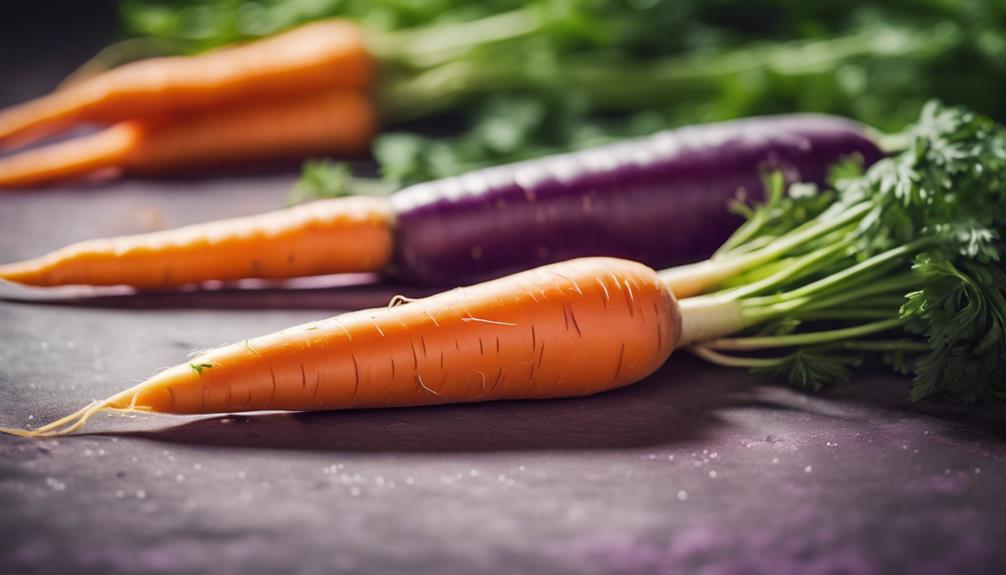
Selecting fresh, organic whole carrots is vital for guaranteeing the best nutrition when preparing homemade baby food. Carrots are packed with important nutrients like vitamin A, which is essential for eye health and immunity. They also contain vitamin C, iron, calcium, and fiber, making them a well-rounded choice for your baby.
When choosing carrots, opt for organic whole carrots to maximize their nutrient content. Remember to wash the carrots thoroughly, peel them to remove any dirt or pesticides, and chop them into small pieces before cooking to ensure food safety. By following these steps, you can provide your baby with a wholesome and nutritious meal.
Homemade carrot puree offers a fresher and more nutrient-rich option compared to store-bought baby food, giving you control over the ingredients and quality of the food your baby consumes.
Making Carrot Puree
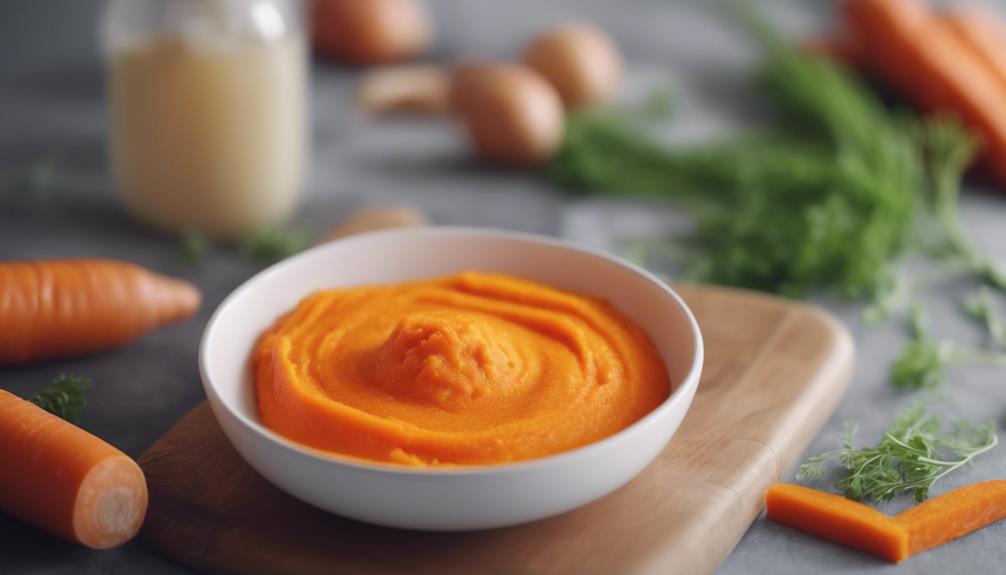
To prepare carrot puree for your baby, begin by peeling and chopping fresh organic carrots into manageable chunks. Make sure to wash the carrots thoroughly before starting.
Next, cook the carrots by steaming, boiling, or roasting until they're tender. Once the carrots are soft, allow them to cool before blending them into a smooth puree.
You can adjust the consistency of the homemade carrot puree by adding breast milk, formula, or water to achieve the desired texture for your baby.
Carrots are a great base for baby food combinations due to their mild flavor and natural sweetness. When introducing solids for the first time, carrots are often a hit with babies because of their pleasant taste.
Store any leftover carrot puree in the fridge for up to three days, or freeze it in ice cube trays for convenient portions that can be thawed as needed. This easy-to-make puree is a nutritious addition to your baby's diet, providing essential vitamins and minerals for healthy growth and development.
Storing Carrot Baby Food
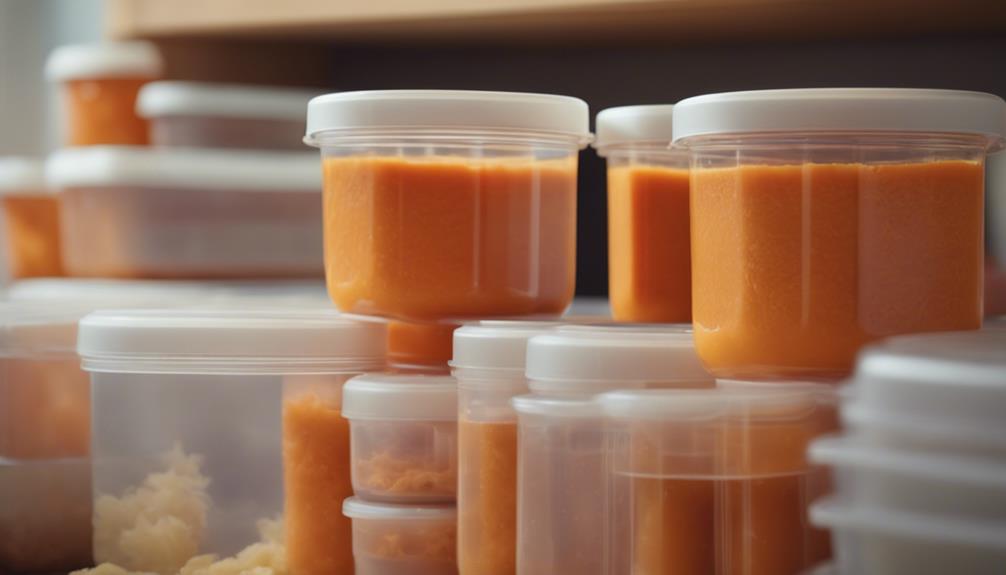
Consider storing your homemade carrot puree in BPA-free containers or silicone ice cube trays for convenient preservation.
Here are some tips for storing carrot baby food effectively:
- Use glass containers for larger portions of carrot puree.
- Label storage containers with the preparation date to track freshness.
- Store the carrot puree in the refrigerator for up to 3 days for immediate use.
Freeze the carrot puree in silicone ice cube trays for portioning and longer shelf life. Silicone ice cube trays are ideal for freezing small portions of carrot baby food for future use.
Cooking Methods and Nutrition Facts
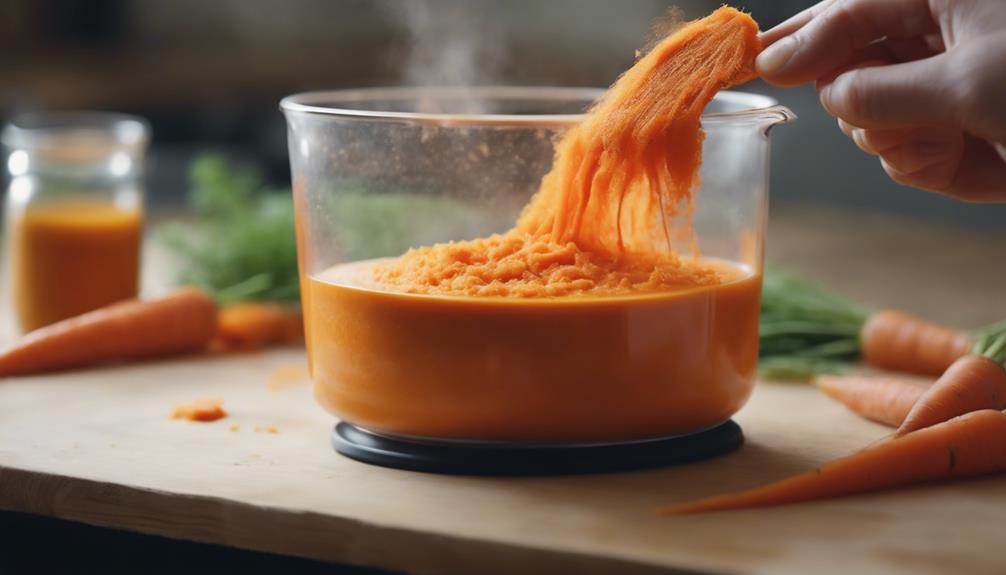
When preparing carrot puree for your baby, consider different cooking methods like boiling, roasting, or steaming. Each technique affects both the flavor and nutrient content of the final dish.
Make sure to adjust the cooking time based on your desired texture for the puree.
Cooking Techniques
Boiling, roasting, or steaming carrots are common methods to prepare nutritious carrot puree for your baby, offering a variety of textures to suit their preferences. Here are some tips for perfecting your carrot puree cooking techniques:
- Boil: Boiling carrots is a quick method that helps retain nutrients. Simply cook until soft for easy blending.
- Roast: Roasting carrots enhances their natural sweetness. Drizzle with olive oil and roast until tender for a caramelized flavor.
- Steam: Steaming carrots preserves nutrients and color. Steam until soft for a smooth puree texture.
- Adjust Cooking Time: Depending on your baby's preferred consistency, adjust the cooking time to achieve the desired texture.
- Ideal for Babies: Carrot puree is ideal for babies starting solids at 6 months, providing essential nutrients for their growth and development.
Experiment with these cooking techniques to create a delicious and nutritious carrot puree that your baby will love.
Nutritional Content
Carrots offer essential nutrients like beta-carotene, vitamin A, iron, calcium, and fiber, vital for your baby's growth and development.
Beta-carotene in carrots converts to vitamin A, supporting eye health and immunity. Additionally, vitamin C, iron, calcium, and fiber found in carrots contribute to overall health and aid in digestion.
When preparing carrot puree for your baby, consider different cooking methods such as boiling, roasting, or steaming, as they can affect both the flavor and the retention of essential nutrients.
Nutritional facts per serving of carrot puree include 62kcal, 14g of carbs, 2g of protein, and 116mg of sodium, making it a nutritious choice for your little one.
Ideal for babies starting solids at 6 months, carrot puree can be easily reheated using warm water or a microwave, ensuring a convenient and healthy meal option for your baby.
Recipe Overview and Ingredients
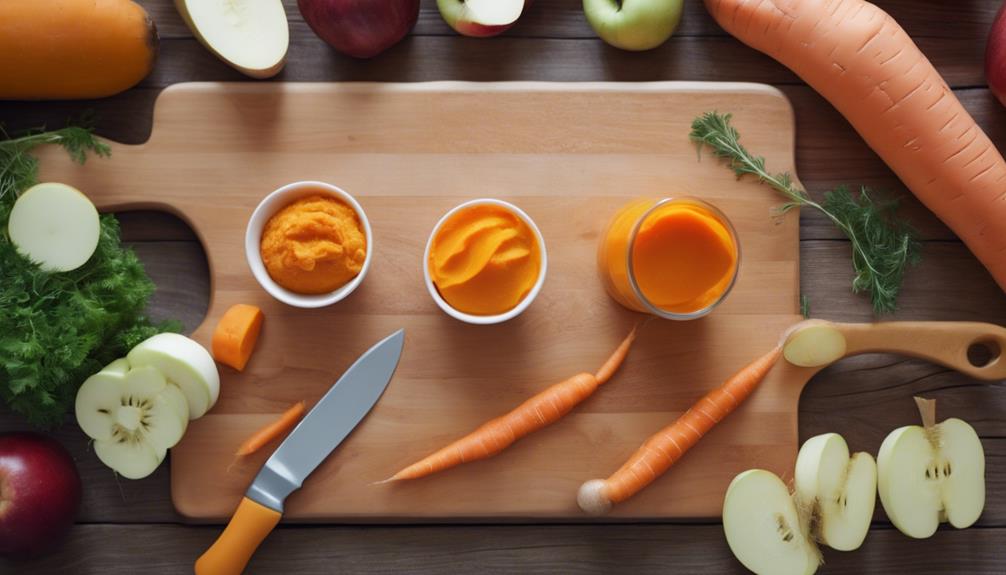
Consider trying out this Carrot Puree Recipe, ideal for your baby's mealtime. The ingredients are simple and healthy, with a focus on fresh organic carrots and a touch of nutmeg for added flavor. Making this puree at home isn't only cost-effective but also guarantees that your little one gets vital nutrients like beta-carotene, vitamin A, and fiber.
The beauty of this recipe lies in its adaptability to different consistencies, catering to your baby's specific needs.
- Fresh organic carrots
- Optional nutmeg for flavor
- Cost-effective ingredients
- Vital nutrients like beta-carotene and vitamin A
- Adjustable consistency to suit your baby's preferences
Frequently Asked Questions
Is Homemade Carrot Puree Safe for Babies?
Homemade carrot puree is safe for babies when prepared with fresh ingredients and proper hygiene. It provides essential nutrients for growth. Avoid adding salt, sugar, or honey. Store leftovers properly and check for spoilage before feeding.
Can Babies Eat Carrot Puree Everyday?
You can offer carrot puree to babies daily as part of a diverse diet. It provides essential nutrients like vitamins A and C. Remember to introduce various foods for balanced nutrition. Consult your pediatrician for personalized guidance.
How to Make Carrot Puree for Baby Without Blender?
If you're without a blender, mash cooked carrots with a fork for a smooth puree. For a finer texture, try a potato masher or food mill. Confirm carrots are soft for easy hand-mashing. Adjust consistency to suit your baby.
Is Carrot Puree Easy to Digest?
Yes, carrot puree is easy to digest. The cooking process breaks down the fiber, aiding digestion. Its gentle nature on the stomach makes it a suitable choice for babies starting solids, promoting a smooth shift to solid foods.
Conclusion
To sum up, making your own carrot puree for your baby is a simple and healthy choice. With the nutritional benefits of carrots and the ease of preparation, it's a great option for introducing solids to your little one.
So next time you're looking for a nutritious and delicious meal for your baby, consider giving this homemade carrot puree recipe a try. Your baby's taste buds and health will thank you!

